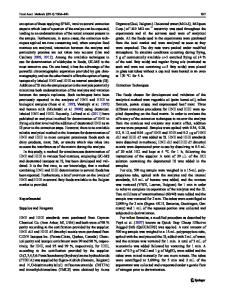Development of a LC-MS/MS method using stable isotope dilution for the quantification of individual B 6 vitamers in frui
- PDF / 1,047,336 Bytes
- 16 Pages / 595.276 x 790.866 pts Page_size
- 97 Downloads / 249 Views
RESEARCH PAPER
Development of a LC-MS/MS method using stable isotope dilution for the quantification of individual B6 vitamers in fruits, vegetables, and cereals Thomas Bachmann 1 & Andrea Maurer 1 & Michael Rychlik 1 Received: 21 March 2020 / Revised: 24 July 2020 / Accepted: 3 August 2020 # The Author(s) 2020
Abstract Vitamin B6 comprises an important set of molecules tightly interwoven with the human amino acid, fatty acid, and carbohydrate metabolism. Analytical methods striving for the quantification of individual B6 vitamers so far mostly rely on methods based on HPLC in combination with fluorescence detection, but their application encounters multiple difficulties due to the chemical divergence of the single vitamers. The present study describes the development of a method based on LC-MS/MS and stable isotope dilution assay (SIDA) for the simultaneous quantification of five vitamers (PN, PL, PM, PMP, and PNG) of the B6 group in food samples. [13C3]-PN, [13C3]-PL, and [13C6]-PNG were applied as internal standards for the analysis of PN, PL, and PNG. PM and PMP were quantified via matrix-matched calibration referring to [13C3]-PN. The developed method was validated using starch matrix. The limits of detection and quantification ranged from 0.0028 to 0.02 mg/kg and from 0.0085 to 0.059 mg/kg, respectively, for all analytes. Calculated recoveries varied from 92 to 111%. Intra-injection precisions ranged from 0 to 9%, interday precisions from 4 to 10%, and intra-day precisions from 4 to 10%. A total of 14 plant-based food samples including fruits, vegetables, and cereals were examined for their content of vitamin B6 using the validated method. Furthermore, the first quantitation of PNG without enzymatic steps or divergent internal standards was undertaken utilizing LC-MS/MS and SIDA. Keywords Food . LC-MS/MS . Stable isotope dilution assay . Pyridoxine . Pyridoxal . Pyridoxamine
Abbreviations CE Collision energy PN Pyridoxine PL Pyridoxal PM Pyridoxamine PLP Pyridoxal phosphate PMP Pyridoxamine phosphate PNP Pyridoxine phosphate Electronic supplementary material The online version of this article (https://doi.org/10.1007/s00216-020-02857-5) contains supplementary material, which is available to authorized users. * Michael Rychlik [email protected] Thomas Bachmann [email protected] Andrea Maurer [email protected] 1
Chair of Analytical Food Chemistry, Technical University of Munich, Maximus-von-Imhof-Forum 2, 85354 Freising, Germany
PNG SSA
Pyridoxine glycoside Sulfosalicylic acid
Introduction The group of vitamin B6 encompasses several water-soluble, essential, yet in vivo inter-convertible, vitamers, namely pyridoxine (PN), pyridoxal (PL), pyridoxamine (PM), and their respective phosphorylated compounds pyridoxine 5′-phosphate (PNP), pyridoxal 5′-phosphate (PLP), and pyridoxamine 5′-phosphate (PMP) [1]. In plants, the glycosylated derivative pyridoxine-5′-β-D-glucoside (5′-β-PNG) accounts for the major fraction of the total vitamin B6 content, additionally (Fig. 1) [2–4]. Vitamin B6 plays an i
Data Loading...











